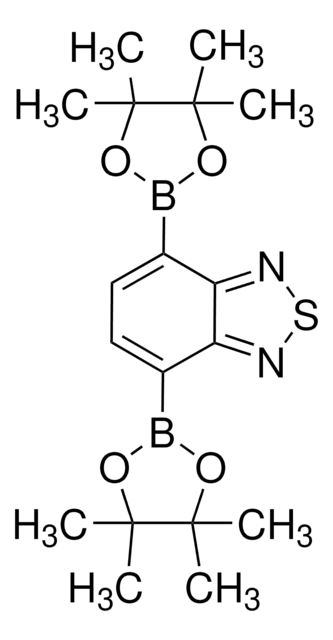Unfortunately, the number of repeat units is not determined. The inherent and reduced viscosities are 0.512 and 0.526 dL/g, respectively. The viscosities are measured by dissolving the product in concentrated sulfuric acid to form a solution with a concentration of 0.0998 g/dL at 25°C.
667846
BBL
Sinônimo(s):
Poly(benzimidazobenzophenanthroline)
Selecione um tamanho
Selecione um tamanho
About This Item
Produtos recomendados
descrição
Band gap: 1.9 eV
Nível de qualidade
Formulário
solid
Energia orbital
HOMO -5.9 eV
LUMO -4.0 eV
Desempenho do dispositivo OPV
ITO/MEH-PPV/BBL/Al
- Short-circuit current density (Jsc): 1.98 mA/cm2
- Open-circuit voltage (Voc): 0.93 V
- Fill Factor (FF): 0.47
- Power Conversion Efficiency (PCE): 1.1 %
ITO/PPV/BBL/Al
- Short-circuit current density (Jsc): 2.15 mA/cm2
- Open-circuit voltage (Voc): 1.1 V
- Fill Factor (FF): 0.5
- Power Conversion Efficiency (PCE): 1.5 %
propriedades semicondutoras
N-type (mobility=0.1 cm2/V·s)
P-type (mobility=0.4 cm2/V·s)
Código de classe de armazenamento
11 - Combustible Solids
Classe de risco de água (WGK)
WGK 3
Ponto de fulgor (°F)
Not applicable
Ponto de fulgor (°C)
Not applicable
Equipamento de proteção individual
Eyeshields, Gloves, type N95 (US)
Escolha uma das versões mais recentes:
Já possui este produto?
Encontre a documentação dos produtos que você adquiriu recentemente na biblioteca de documentos.
Artigos
Intrinsically stretchable active layers for organic field-effect transistors (OFET) are discussed. Polymer structural modification & post-polymerization modifications are 2 methods to achieve this.
Fabrication procedure of organic field effect transistor device using a soluble pentacene precursor.
Thin, lightweight, and flexible electronic devices meet widespread demand for scalable, portable, and robust technology.
Professor Chen (Nankai University, China) and his team explain the strategies behind their recent record-breaking organic solar cells, reaching a power conversion efficiency of 17.3%.
-
Hello, What is the number of repeat unit or viscosity of this polymer?
1 answer-
Helpful?
-
-
Is there any molecular weight information available for the BBL polymer (item # 667846)?
1 answer-
The molecular weight for this product is not determined. However, historical data suggest that it is 304.2 g/mol.
Helpful?
-
-
Hello, what is the viscosity (or number of repeat units) of this polymer?
1 answer-
The viscosity of this material is not tested on a lot-to-lot basis. However, historical data indicates an intrinsic viscosity of approximately 1.6 dl/g in Methanesulfonic acid at 25°C.
Helpful?
-
Active Filters
Nossa equipe de cientistas tem experiência em todas as áreas de pesquisa, incluindo Life Sciences, ciência de materiais, síntese química, cromatografia, química analítica e muitas outras.
Entre em contato com a assistência técnica![Naphtho[1,2-c:5,6-c′]bis[1,2,5]thiadiazole-5,10-diboronic acid bis(pinacol) ester 95%](/deepweb/assets/sigmaaldrich/product/structures/396/334/bb0914db-5c9a-4565-ba76-30dd4bc4ba87/640/bb0914db-5c9a-4565-ba76-30dd4bc4ba87.png)








